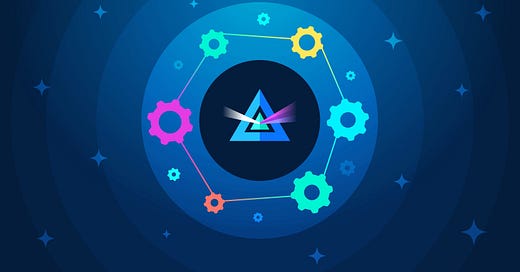Download Beam Wallet for: Android | iOS | Desktop | Web
Greetings Beamers!
Presenting the Beam Bi-weekly Newsletter—June 2024 Ed.#1, covering all the latest developments in the Beam ecosystem from May 30 - June 12.
Beam Wallet Widgets
What are “Widgets”?
A widget is a small lightweight card that will run on your Beam Wallet and provide quick access to information related to some of your favorite Dapps.
But in contrast to DApps, widgets are non-interactive, can be invoked automatically on each blockchain change (e.g. a new block), and are limited to just fetching and displaying information.
Widgets are not able to create transactions or communicate via SBBS.
Why do we need widgets?
The idea for widgets was inspired by the limited functionality of the existing “Beam Price Broadcaster".
While we have on-chain oracle integrations to fetch the most accurate BEAM price, that information is only accessible by DApps. Widgets can display the latest price information, tailored to the needs of the user.
How do widgets benefit Beam users?
Overall, Widgets will provide you with rich information, that is displayed, and easily accessible at a glance in the Beam Wallet.
For example, Nephrite ($NPH) is the private-by-default decentralized stablecoin on the BEAM ecosystem.
A Nephrite widget could display the current BEAM price, $NPH price, as well as information specific to the Nephrite DApp, such as total NPH emission, Total Value Locked (TVL) etc.
In the Command-line-Interace (CLI) Beam Wallet, widget messages are printed in the console. For the GUI Beam Desktop Wallet, we're currently developing the necessary UI/UX, that will allow you to install/uninstall such widgets, view their statuses, and more.
The Smart Explorer and it’s new contributor
We welcome DB, who developed further updates for the Smart Explorer v0.4, which improves the display of multiple contract calls and many other enhancements and corrections.
You can download it here.
Our core developer, Vladi, has made several improvements to the Smart Explorer too;
Previously the “amount” type was returned displayed either as a negative or positive number, with appropriate styling and colour.
However in many instances, the amount should be treated as unsigned number, that is negative numbers are inapplicable there.
To reflect this, the explorer node now returns the amount with '-' for negative amounts, '+' for positive, and without the sign for unsigned numbers.
So that we now have 3 distinct styles: positive, negative, unsigned.
The “hdrs” query was updated, in addition to the “nMax” and “hMax” parameters, it now allows flexible control on which data columns you’d like to get, and with which steps.
The following parameters were added:
"dh" - the delta Height. By default it's 1. If you set other (bigger) value, you'll get the data from the top height, then down by steps of the specified "dh", until "nMax" rows returned or the lowest height reached, whatever comes first.
This is for drawing charts with arbitrary resolution.
In addition there're parameters "cabs" and "crel". Those control which data columns you want to get in Absolute and Relative terms.
Those are specified as strings, where each character corresponds to a specific data type that should be included in the result.
The characters to data mapping can be seen here.
For example here:
https://github.com/BeamMW/beam/blob/vlad_20240530/explorer/htm/BeamExplorer.htm#L1263
The default hdrs view in BeamExplorer.htm would use the following parameters:
cabs=&crel=dfkoOiIC
"cabs" is empty, meant we don't display the totals in this screen. We display only relative differences (deltas between blocks).
The "crel" is set to "dfkoOiIC". Which means difficulty, fee, num of kernels, MW outputs, Shielded outputs, MW inputs, shielded inputs, and contract calls.
If you use 'd' in "cabs" it'll be the Total difficulty (a.k.a. chainwork), 'f' would be the total fees of all blocks up to this height, 'k' - total number of kernels up to this height, and so on.
MathNodes launches Beam Node
MathNodes is self-described as “a cosmos ecosystem team of validators, comprised of Sentinel dev team. BEAM devs. XMR enthusiasts. Privacy advocates. Node runners.”
They’ve launched their own public node, allowing users and DApps to easily connect to the Beam blockchain.
Beam Community Spotlight
Beam is powerful! - courtesy of @JiuCrypto
That wraps up this edition of the Beam Newsletter. If you haven’t read the last newsletter yet, you can do that here.
Be sure to sign up and stay tuned for more exciting updates and announcements from the Beam ecosystem.
Until next time, stay safe and keep it private by default!
Best Regards,
The Beam Team







